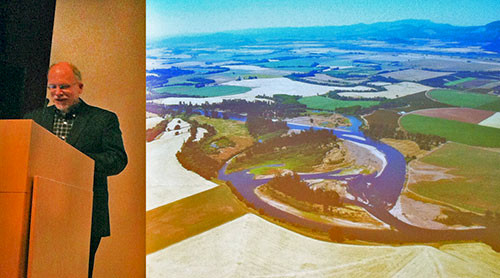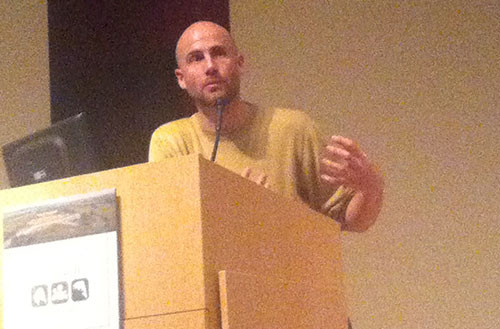Willamette Through Film festival
Bill Dennison ·I attended the biennial Within Our Reach conference, held on the Oregon State University campus in Corvallis, Oregon. The conference kicked off with a film night, "Willamette Through Film". Three short films were shown in a chronological sequence. The first film from 1939 was sponsored by the Isaac Walton League. They didn't have enough money for a soundtrack so it was a silent film. But Dr. Stan Gregory from Oregon State University provided an entertaining running commentary. I think that this was more effective than listening to a soundtrack, as soundtracks quickly become dated. Stan really made the film come alive, and this mode of combining old footage with modern narration was a fantastic communication technique. The historic footage was compelling by using very visual geographic references (e.g., shots of the state capital in Salem and "Welcome to . . ." road signs) and bioassays of juvenile salmon. The thrashing, dying fish and jars of colored river water made the graphic point that the Willamette was unfit for fish life. This compelling film showcased the awful pollution that existed at the time. The pulp and paper mills discharged highly contaminated water into the Willamette River. In addition, untreated sewage also entered the river. Stan and I talked afterward about finding some of the sites from this 1939 film and repeating the bioassay experiments to contrast the historical conditions vs. current, improved conditions. Stan pointed out the unfortunate timing of the realization that environmental improvements needed to occur with the onset of World War II, which delayed the implementation of water quality controls.

The next film was titled "Pollution in Paradise", a 1962 documentary by Tom McCall, a journalist who went on to become a popular governor of Oregon. This film had fairly graphic footage of fish kills, foam and debris on the water surface, dams, and stormwater pipes discharging into the river. The timing of this film associated with a growing environmental awareness meant that this film helped get the Willamette clean up started in earnest.
The final film was a preview of "Willamette Futures" by Jeremy Monroe, Freshwaters Illustrated. There were several noteworthy features of this film. First, the absolutely stunning cinematography was captivating. Jeremy included some unusual and visually compelling perspectives, like underwater views of the fish and benthic habitat, views looking upward to people paddling canoes and dizzying views of logs being lifted by helicopters. Second, Jeremy featured interviews with landowners and farmers walking around their properties explaining their view of their land practices and the Willamette River. Images of farmers standing in sunlit, golden grasses or walking alongside riparian plantings combined with their obvious passion about being good conservation stewards made for unique footage. Third, Jeremy covered the breadth of the river, from headwaters to tributaries to the mainstream of the Willamette River. My suggestion was to include some contextual satellite or high altitude photography to provide geographic context to outsiders like myself, and enter the film into national film festivals because he has produced something quite extraordinary.

Reflecting on this triad of films, they represented a comprehensive exposition of scales: spatial scales through the length of the river system, temporal scales with the rich historical perspective captured in the three time periods, and complexity scales with the diversity of issues, people and ecosystem features illustrated. They also captured the passion expressed by people throughout the 1939-present time span. Different issues and different champions, but an enduring passion was evident. In my short visit to the Willamette valley, I did not have the opportunity to explore the river in person, but through these films, shared by some incredibly knowledgeable and passionate people, I have a sense of this mighty river and what it means to the Oregonians who live in its watershed.
About the author
Bill Dennison

Dr. Bill Dennison is a Professor of Marine Science and Vice President for Science Application at the University of Maryland Center for Environmental Science.

